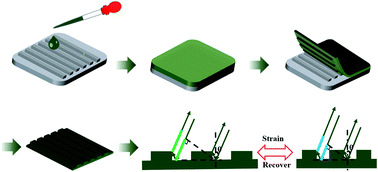Panther chameleon-inspired, continuously-regulated, high-saturation structural color of a reflective grating on the nano-patterned surface of a shape memory polymer†
Abstract
In this work, surface nano-stripes and a reflective grating have been fabricated on shape memory polymers (SMPs) to simulate the active color change of chameleons. The structural color resulting from the interference of reflected light exhibits high saturation and it can be regulated continuously based on the shape memory effect. In addition to the viewing angle, the attained color is sensitive to the deformation at the macroscale. Uniaxial tension along stripes at high temperature produces a remarkable blueshift of the resultant color (from red to green and blue) which can switch back to red after shape recovery upon heating. The evolution of structural color can be attributed to the lower and higher magnitudes of nano-structure periods in temporary (deformed) and permanent (recovery) states respectively. Based on the combination of angle and deformation dependences of structural color, a “colorful” product code has been fabricated. It exhibits enhanced ability to hide and display information which plays an important role in anti-counterfeiting.



 Please wait while we load your content...
Please wait while we load your content...